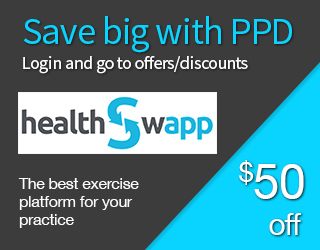By Rick Lau
I cover entrepreneurship, digital marketing, and practice management.
If you own a physiotherapy clinic, you’ve probably spent a pretty penny on marketing. Seeing as how you lose 14% of your customers every year, you can’t afford not to.
Even the most inexperienced owners know that the more you spend on marketing, the higher your chances of getting more phone calls to the front desk.
Considering how much effort everyone is putting into their marketing strategies, it’s strange to see how little effort some clinics put into converting phone calls into bookings. All the physical therapy marketing in the world isn’t going to make up for the fact that you and your staff can’t seem to translate those calls into new clients.
New patient phone calls can make or break your practice.
While you may have a list somewhere that walks you through what to do with a new client, you probably aren’t familiar with the 4 deadly sins that ruin new patient phone calls. So, let’s stop worrying about creating the next great marketing idea for a second and focus on what matters: turning those potential clients into real ones.
1. Not Keeping Track of Everything
For whatever reason, the concept of metrics gets thrown out the window the moment a potential client calls in. It’s really a shame because, if you’re serious about converting phone calls, you should be focused on collecting as much data as possible.
When we say measure everything, we mean it. Figure out how many phone calls your front desk misses in a week. Find out which one of your administrators is the best at converting potential new patients. Keep track of the relative frequency of calls and what time of day you receive the most calls.
Once you’ve done that, start asking yourself the questions that matter. Why aren’t people booking with you? It could be a price issue, a scheduling conflict or just not offering the services they are seeking. If you own a few clinics, why is one clinic converting more than the rest? No matter what the reason is, we need to figure it out. By isolating the reasons you succeed and fail, you’ll be able to create a more efficient system for converting callers.
Let’s say you’ve got a client calling in after reading your Google reviews. While most administrators know to ask for their phone number, all too often, they forget to ask new patients their email address. If you have their email address, you can send them an appointment reminder and put them in your future marketing campaigns.
Download Guide: 10 Ways To Get Started on Social Media for Your Practice
Start Building Trust and Getting New Patients
Click here to get your Social Media Trust Building Guide
2. Forgetting Your Manners
There’s something to be said about the importance of first impressions. When it comes to your health practice, this phone call is very likely to be the first interaction that your potential client has had with you.
There’s a bit of a balancing act that goes on when someone works the front desk at a clinic. First off, they have to be somewhat of a sales person. They must have an end goal in mind when it comes to potential new clients.
Of course, everyone knows that you catch more flies with honey than you do with vinegar. If you’re serious about new patient call conversions, your staff will need to establish a certain level of phone skills.
Train your staff to ask for a caller’s name and use it throughout the conversation. Your administrators should acknowledge the potential client’s pain, not just skip ahead to asking them to schedule an appointment.
When presented with the opportunity, your staff should avoid industry terminology and use simple language with the caller. This will help potential clients feel more in control of the process and less intimidated by everything.
Being polite and professional is the stuff that high-quality customer service is all about. Have your staff wish the caller well at the end of the call (regardless of the outcome). Make sure your staff asks if there’s anything else they can do for the caller. If you’re interested in a few more ways to make your clients feel welcome, we’ve got a few ideas on how to make that happen.
Above all else, your front desk staff needs to understand that every call is a unique experience. Establishing a dialog with someone leaves a lasting impression and, more importantly, shows them that you care.
3. Not Determining Their Needs
This might be one of the biggest sins on this list. Frankly, it’s the most expensive mistake an administrator can make. Why? Because establishing what a client needs is an essential part of the conversion process. They can’t solve a client’s problem if they don’t know what it is, can they?
Clients (especially new ones) need to feel accommodated. They thrive off that feeling of being taken care of. More importantly, they appreciate the initiative.
Now, if a client asks your staff about pricing, how are they trained to respond? Hopefully, they’ve been taught the importance of reframing the question. Don’t give them the price but instead get them to talk about their pain. You can use these reframing questions “How long ago did the pain start?”, “What have you been doing”, “What happened”, “How do you feel”.
Remember: giving the client the price right away doesn’t help them make a decision, it creates a mental block that prevents them from appreciating your services. The caller wants their pain managed. Before you can even think about mentioning a price, you need to convince them that their problem will be addressed. Mentioning price right away gets them in “no” mentality which, as you can imagine, makes converting them much harder.
No one is asking your front desk staff to diagnose a client over the phone. All they really need to do is paraphrase the issue back to the client (to make sure they heard it correctly), make a note of the issue and make a comment on how irritating that must be. Seriously, that alone is a level of engagement that will put your clinic leaps and bounds ahead of the competition.
4. If You Don’t Ask, You Don’t Get
The hardest part of being a sales person (a responsibility that your front desk staff will now carry) is knowing when to shift gears. Being polite and courteous is critical to developing a connection with your potential client, but it’s all pointless if you don’t know how to ask for their business.
Now, this might seem a bit contradictory to our earlier advice. “I thought the whole point here was to develop a relationship”, you might be thinking. And you’re right…except for one thing. Developing a relationship isn’t the only thing you should be worried about: it’s the first thing you should be worried about.
Once they’ve established a rapport, your staff has to take that next step. The key here is implying success. They should also talk about the benefits of the physiotherapist and how they can fix their problem. They shouldn’t ask “can I set you up for an appointment?” They should ask “what day works best for you this week?
Most clients aren’t chomping at the bit to sign up for appointments. Your staff needs to take the reins and guide this potential client through the phone call conversion process. Let your potential clients know that the sooner they act, the sooner their problem will go away. Schedules fill up quickly, after all. If you’re having a hard time convincing your staff about the importance of this, just remember: sometimes you’re just a few “no’s” away from success.
Here’s an easy way to look at this: let’s say you get 200 phone calls per month and 30% of those phone calls end up being new patient inquiries. If that’s the case, you’ll have about 60 potential leads per month.
Now, if you are answering 60% of the phone calls and converting 50% of the callers, you’ll end up with 18 new patients (60 x 60% x 50%= 18). Which is fine…but what if you could do better?
What if you were answering 90% of phone calls? And what if you were able to convert 80% of the callers? That alone would book 43 new patients (60 x 90% x 80% = 43). That is an extra 25 clients per month.
Annually? That could get you an extra 300 clients per year. If you averaged $500 annually from each client, you’ll end up with an additional $150,000 in revenue by the end of the year.
Here’s the cold, hard truth: the clients are out there. They want to do business with someone. You want to be that someone? Make them feel welcome. Pay attention to what they want. And whatever you do, don’t take no for an answer




